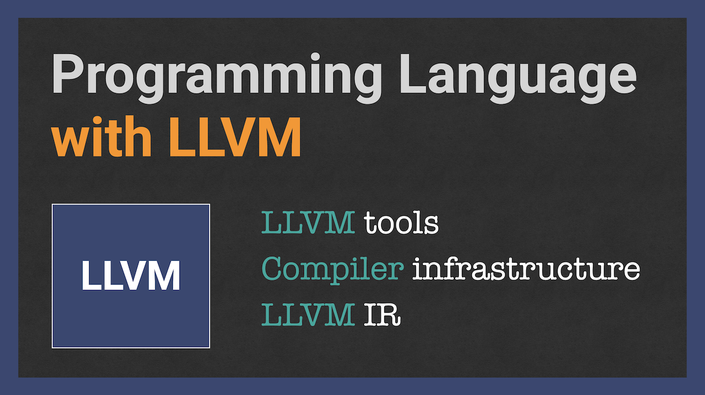
Programming Language with LLVM
Practical approach to programming languages
Course overview
How programming languages work under the hood? What’s the difference between compiler and interpreter? What is a virtual machine, and JIT-compiler? And what about the difference between functional and imperative programming?
There are so many questions when it comes to implementing a programming language!

The problem with “compiler classes” in school is such classes are usually presented as some “hardcore rocket science” which is only for advanced engineers.
Moreover, classic compiler books start from the least significant topic, such as Lexical analysis, going straight down to the theoretical aspects of formal grammars. And by the time of implementing the first Tokenizer module, students simply lose an interest to the topic, not having a chance to actually start implementing a programing language itself. And all this is spread to a whole semester of messing with tokenizers and BNF grammars, without understanding an actual semantics of programming languages.
I believe we should be able to build and understand a full programming language semantics, end-to-end, in 4-6 hours — with a content going straight to the point, showed in live coding sessions as pair-programming and described in a comprehensible way.
In the Programming Language with LLVM class we focus on compiling our language to LLVM IR, and build a lower-level programming language. Working closely with the LLVM compiler infrastructure level you will understand how lower-level compilation and production-level languages, such as C++, Rust, etc work today.
Implementing a programing language would also make your practical level in other programming languages more professional.

Prerequisites
There are two prerequisites for this class.
The Programming Language with LLVM course is a natural extension for the previous classes — Building an Interpreter from scratch (aka Essentials of Interpretation), where we build also a full programming language, but at a higher, AST-level, and also Building a Virtual Machine. Unless you already have understanding of how programming languages work at this level, i.e. what eval, a closure, a scope chain, environments, and other constructs are — you have to take the interpreters class as a prerequisite.
Also, going to lower (bitcode/IR) level where production languages live, we need to have basic C++ experience. This class however is not about C++, so we use just very basic (and transferrable) to other languages constructs.
Watch the introduction video for the details.
Who this class is for?
This class is for any curious engineer, who would like to gain skills of building complex systems (and building a programming language is an advanced engineering task!), and obtain a transferable knowledge for building such systems.
If you are interested specifically in LLVM, its compiler infrastructure, and how to build your own langauge, then this class is also for you.
What is used for implementation?
Since lower-level compilers are about performance, they are usually implemented in a low-level language such as C or C++. This is exactly what we use as well, however mainly basic features from C++, not distracting to C++ specifics. The code should be easily convertible and portable to any other language, e.g. to Rust or even higher-level languages such as Python. Using C++ also makes it easier implementing further JIT-compiler.
Note: we want our students to actually follow, understand and implement every detail of the VM themselves, instead of just copy-pasting from final solution. Even though the full source code for the language is presented in the video lectures, the code repository for the project contains /* Implement here */ assignments, which students have to solve.
What’s specific in this class?

The main features of these lectures are:
- Concise and straight to the point. Each lecture is self-sufficient, concise, and describes information directly related to the topic, not distracting on unrelated materials or talks.
- Animated presentation combined with live-editing notes. This makes understanding of the topics easier, and shows how the object structures are connected. Static slides simply don’t work for a complex content.
- Live coding session end-to-end with assignments. The full source code, starting from scratch, and up to the very end is presented in the video lectures
What is in the course?
The course is divided into four parts, in total of 20 lectures, and many sub-topics in each lecture. Below is the table of contents and curriculum.
PART 1: LLVM BASIC CONSTRUCTS
In this part we describe compilation and interpretation pipeline, starting building our language. Topics of LLVM IR, object, compilation of the bitcode are discussed.
PART 2: FUNCTIONS AND STACK
In this part we implement control flow structures such as if expressions and while loops, talk about stack variables, nested blocks and local variables, and also compile functions.
PART 3: OBJECT-ORIENTED PROGRAMMING
In this part we implement OOP concepts, such as classes, instances, talk about heap allocation, and garbage collectors.
PART 4: HIGHER-ORDER FUNCTIONS
In this part we focus on closures, functional programming, lambda functions, and implement the final executable.
Your Instructor

Dmitry Soshnikov is a Software engineer, and a lecturer on different computer science topics.
He is passioned about education, and focuses on high-quality educational content: concise and straight to the point animated lectures with live-editing notes.
You will learn:
- Compilers and interpreters: building a Programing language
- Garbage Collectors (Automatic memory management)
- Theory of programming languages
- Automata Theory: Building a RegExp machine
- Parsers theory: Implementing a Parser Generator
Course Curriculum
-
PreviewLecture 1: Introduction to LLVM IR and tools (13:33)
-
PreviewLecture 2: LLVM program structure | Module (6:17)
-
PreviewLecture 3: Basic numbers | Main function (10:20)
-
PreviewLecture 4: Strings | Printf operator (6:43)
-
PreviewLecture 5: Parsing: S-expression to AST (10:23)
-
StartLecture 6: Symbols | Global variables (6:39)
-
StartLecture 7: Blocks | Environments (9:59)